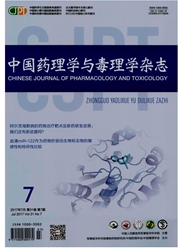

 中文摘要:
中文摘要:
目的通过建立神经干细胞(NSC)体外衰老模型,探讨蛇床子素(Ost)延缓NSC衰老的作用,并探讨其可能调控机制。方法体外培养NSC,在增殖培养基中传代纯化培养至第3代,用于细胞实验。利用叔丁基过氧化氢(t-BHP)50,100和150μmol·L^-1分别与NSC孵育1,2和3 h,CCK-8法检测细胞存活率,确定t-BHP 100μmol·L^-1与NSC孵育2 h为制备细胞衰老模型的最佳条件。再加入Ost 50,100和150μmol·L^-1作用1,2和3 h,CCK-8法检测细胞存活率,选择Ost促进细胞存活的最佳作用浓度和作用时间。实验分为细胞对照组、衰老模型组(NSC与t-BHP 100μmol·L^-1作用2 h)和模型+Ost组(NSC与t-BHP 100μmol·L^-1作用2 h后,再与Ost 100μmol·L^-1作用2 h),用Ki67染色法检测NSC细胞增殖能力,免疫组化法检测NSC分化能力,衰老β-半乳糖苷酶(Sa-β-gal)法检测衰老细胞百分率,RT-PCR法检测p53,p21,p19和p16基因表达,Western蛋白印迹法检测P16、细胞周期蛋白依赖性激酶D1(CDKD1)和磷酸化成视网膜细胞瘤蛋白(p Rb)蛋白表达。结果 Ost 100μmol·L^-1作用2 h可明显促进NSC存活(P〈0.01)。与细胞对照组相比,模型组NSC增殖能力明显下降(P〈0.05),分化为星形胶质细胞、神经元和少突胶质细胞的能力亦明显下降(P〈0.05),Sa-β-gal阳性衰老细胞百分率升高(P〈0.01)。与模型组相比,模型+Ost 100μmol·L^-1组NSC增殖能力升高(P〈0.05),分化为星形胶质细胞、神经元和少突胶质细胞的能力亦明显提高(P〈0.05),Sa-β-gal阳性衰老细胞百分率下降(P〈0.01)。RT-PCR结果显示,与模型组相比,模型+Ost100μmol·L^-1组p16和p53 m RNA表达水平降低(P〈0.05),p19和p21 m RNA表达无显著性变化;与模型组相比,模型+Ost 100μmol·L^-1组P16蛋白表达降低,同时CDKD1和p Rb蛋白表达水平明显升高(P〈0.05)。结论 Ost具有延缓t-BHP造成NSC衰老的作用,其延缓NSC衰老作用机制可能?
 英文摘要:
英文摘要:
OBJECTIVE To investigate the effect of osthole (Ost) on retardation of neural stem cells (NSCs) senescence induced by tert-butyl hydroperoxide (~t-BHP) and to study the related mecha- nism in vitro. METHODS NSCs were cultured until the 3rd generation in proliferation medium in vitro and used for subsequent experiments, t-BHP 50, 100 and 150 μmol· L^-1 was incubated with NSCs for 1, 2 and 3 h, and the viability of NSCs was determined using CCK-8 assay. Then, Ost 50, 100 and 150 μmol· L^-1 was added for 1,2 and 3 h to choose the suitable concentration of Ost used in the following experiments. The ability of proliferation of NSCs was tested by Ki67 staining and differentiation by immune staining. Assay for aging cells was measured by senescence β-galactosidas (Sa-β-gal) staining kit. Then, the mRNA expression of p53, p21, p19 and p16 gene was detected by RT-PCR, and the expression of P16, cyclinD1 and pRb proteins was detemined by Western blotting. RESULTS The CCK-8 assay results showed the optimum condition of t-BHP for the NSCs aging model was 100 μmo· L^-1 for 2 h, and the survival rate with Ost treatment increased significantly (P〈0.01). The Ki67 positive rate significantly decreased (P〈0.05), the ability of proliferation into astrocytes, neurons and oligoden- drocytes also decreased (P〈0.05), but Sa-15-gal staining revealed that percentage of aging NSCs increased (P〈0.01) in model group compared with control group. The Ki67 positive rate significantly increased (P〈0.05) , the ability of proliferation into astrocytes, neurons and oligodendrocytes also increased (P〈0.05), and Sa-~-gal staining revealed the decreasing percentage of aging NSCs ( P〈0.01 ) in Ost group compared with model group. The results of RT-PCR showed that the expression of p16 and p53 mRNA levels decreased in Ost group compared with t-BHP group (P〈0.05). The expression of p19 and p21 mRNA was not significantly different between model group and Ost group. The results of Wes
 同期刊论文项目
同期刊论文项目
 同项目期刊论文
同项目期刊论文
 CCR5-Transduced Neural Stem Cells Confer Accelerated and Enhanced Therapeutic Effect on Experimental
CCR5-Transduced Neural Stem Cells Confer Accelerated and Enhanced Therapeutic Effect on Experimental Epoxyaurapten inhibition of smooth muscle contraction and phosphorylation of myosin light chain by m
Epoxyaurapten inhibition of smooth muscle contraction and phosphorylation of myosin light chain by m Osthole confers neuroprotection against cortical stab woundinjury and attenuates secondary brain inj
Osthole confers neuroprotection against cortical stab woundinjury and attenuates secondary brain inj Ostholepromotes neuronal differentiation and inhibits apoptosis via Wnt/β-cateninsignaling in an Alz
Ostholepromotes neuronal differentiation and inhibits apoptosis via Wnt/β-cateninsignaling in an Alz Osthole Augments Therapeutic Efficiency of Neural Stem Cells-Based Therapy in Experimental Autoimmun
Osthole Augments Therapeutic Efficiency of Neural Stem Cells-Based Therapy in Experimental Autoimmun Neuroprotective Effect of Arctigenin via Upregulation of P-CREB in Mouse Primary Neurons and Human S
Neuroprotective Effect of Arctigenin via Upregulation of P-CREB in Mouse Primary Neurons and Human S Neurotrophin 3 Transduction Augments Remyelinating and Immunomodulatory Capacity of Neural Stem Cell
Neurotrophin 3 Transduction Augments Remyelinating and Immunomodulatory Capacity of Neural Stem Cell The Coumarin Derivative Osthole Stimulates AdultNeural Stem Cells, Promotes Neurogenesis in the Hipp
The Coumarin Derivative Osthole Stimulates AdultNeural Stem Cells, Promotes Neurogenesis in the Hipp Accelerated and enhanced effect of CCR5-transduced bone marrow neural stem cells on autoimmune encep
Accelerated and enhanced effect of CCR5-transduced bone marrow neural stem cells on autoimmune encep Neuroprotective effect of arctigenin via upregulation of p-EREB in mouse primary neurons and human S
Neuroprotective effect of arctigenin via upregulation of p-EREB in mouse primary neurons and human S 期刊信息
期刊信息
